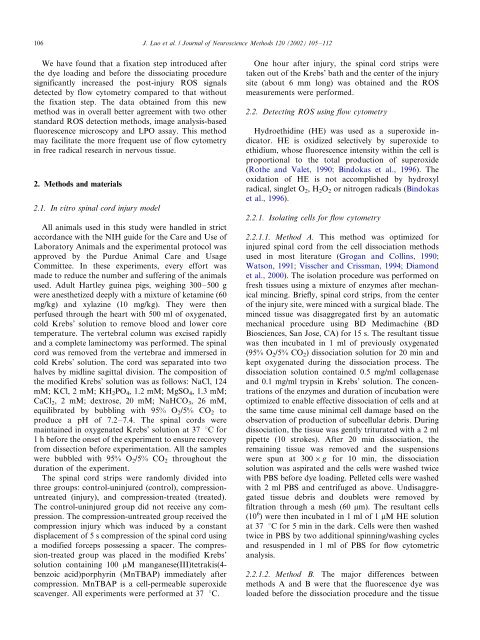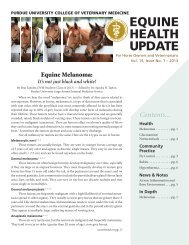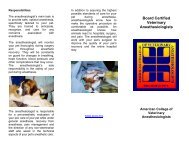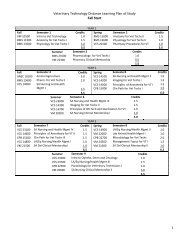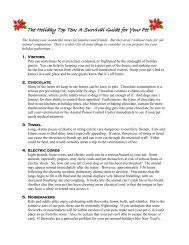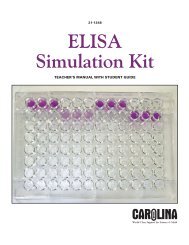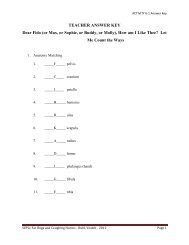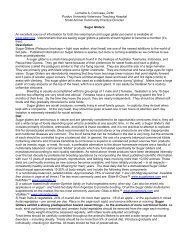Detection of reactive oxygen species by flow ... - ResearchGate
Detection of reactive oxygen species by flow ... - ResearchGate
Detection of reactive oxygen species by flow ... - ResearchGate
You also want an ePaper? Increase the reach of your titles
YUMPU automatically turns print PDFs into web optimized ePapers that Google loves.
106J. Luo et al. / Journal <strong>of</strong> Neuroscience Methods 120 (2002) 105/112We have found that a fixation step introduced afterthe dye loading and before the dissociating proceduresignificantly increased the post-injury ROS signalsdetected <strong>by</strong> <strong>flow</strong> cytometry compared to that withoutthe fixation step. The data obtained from this newmethod was in overall better agreement with two otherstandard ROS detection methods, image analysis-basedfluorescence microscopy and LPO assay. This methodmay facilitate the more frequent use <strong>of</strong> <strong>flow</strong> cytometryin free radical research in nervous tissue.2. Methods and materials2.1. In vitro spinal cord injury modelAll animals used in this study were handled in strictaccordance with the NIH guide for the Care and Use <strong>of</strong>Laboratory Animals and the experimental protocol wasapproved <strong>by</strong> the Purdue Animal Care and UsageCommittee. In these experiments, every effort wasmade to reduce the number and suffering <strong>of</strong> the animalsused. Adult Hartley guinea pigs, weighing 300/500 gwere anesthetized deeply with a mixture <strong>of</strong> ketamine (60mg/kg) and xylazine (10 mg/kg). They were thenperfused through the heart with 500 ml <strong>of</strong> <strong>oxygen</strong>ated,cold Krebs’ solution to remove blood and lower coretemperature. The vertebral column was excised rapidlyand a complete laminectomy was performed. The spinalcord was removed from the vertebrae and immersed incold Krebs’ solution. The cord was separated into twohalves <strong>by</strong> midline sagittal division. The composition <strong>of</strong>the modified Krebs’ solution was as follows: NaCl, 124mM; KCl, 2 mM; KH 2 PO 4 , 1.2 mM; MgSO 4 , 1.3 mM;CaCl 2 , 2 mM; dextrose, 20 mM; NaHCO 3 , 26 mM,equilibrated <strong>by</strong> bubbling with 95% O 2 /5% CO 2 toproduce a pH <strong>of</strong> 7.2/7.4. The spinal cords weremaintained in <strong>oxygen</strong>ated Krebs’ solution at 37 8C for1 h before the onset <strong>of</strong> the experiment to ensure recoveryfrom dissection before experimentation. All the sampleswere bubbled with 95% O 2 /5% CO 2 throughout theduration <strong>of</strong> the experiment.The spinal cord strips were randomly divided intothree groups: control-uninjured (control), compressionuntreated(injury), and compression-treated (treated).The control-uninjured group did not receive any compression.The compression-untreated group received thecompression injury which was induced <strong>by</strong> a constantdisplacement <strong>of</strong> 5 s compression <strong>of</strong> the spinal cord usinga modified forceps possessing a spacer. The compression-treatedgroup was placed in the modified Krebs’solution containing 100 mM manganese(III)tetrakis(4-benzoic acid)porphyrin (MnTBAP) immediately aftercompression. MnTBAP is a cell-permeable superoxidescavenger. All experiments were performed at 37 8C.One hour after injury, the spinal cord strips weretaken out <strong>of</strong> the Krebs’ bath and the center <strong>of</strong> the injurysite (about 6 mm long) was obtained and the ROSmeasurements were performed.2.2. Detecting ROS using <strong>flow</strong> cytometryHydroethidine (HE) was used as a superoxide indicator.HE is oxidized selectively <strong>by</strong> superoxide toethidium, whose fluorescence intensity within the cell isproportional to the total production <strong>of</strong> superoxide(Rothe and Valet, 1990; Bindokas et al., 1996). Theoxidation <strong>of</strong> HE is not accomplished <strong>by</strong> hydroxylradical, singlet O 2 ,H 2 O 2 or nitrogen radicals (Bindokaset al., 1996).2.2.1. Isolating cells for <strong>flow</strong> cytometry2.2.1.1. Method A. This method was optimized forinjured spinal cord from the cell dissociation methodsused in most literature (Grogan and Collins, 1990;Watson, 1991; Visscher and Crissman, 1994; Diamondet al., 2000). The isolation procedure was performed onfresh tissues using a mixture <strong>of</strong> enzymes after mechanicalmincing. Briefly, spinal cord strips, from the center<strong>of</strong> the injury site, were minced with a surgical blade. Theminced tissue was disaggregated first <strong>by</strong> an automaticmechanical procedure using BD Medimachine (BDBiosciences, San Jose, CA) for 15 s. The resultant tissuewas then incubated in 1 ml <strong>of</strong> previously <strong>oxygen</strong>ated(95% O 2 /5% CO 2 ) dissociation solution for 20 min andkept <strong>oxygen</strong>ated during the dissociation process. Thedissociation solution contained 0.5 mg/ml collagenaseand 0.1 mg/ml trypsin in Krebs’ solution. The concentrations<strong>of</strong> the enzymes and duration <strong>of</strong> incubation wereoptimized to enable effective dissociation <strong>of</strong> cells and atthe same time cause minimal cell damage based on theobservation <strong>of</strong> production <strong>of</strong> subcellular debris. Duringdissociation, the tissue was gently triturated with a 2 mlpipette (10 strokes). After 20 min dissociation, theremaining tissue was removed and the suspensionswere spun at 300/g for 10 min, the dissociationsolution was aspirated and the cells were washed twicewith PBS before dye loading. Pelleted cells were washedwith 2 ml PBS and centrifuged as above. Undisaggregatedtissue debris and doublets were removed <strong>by</strong>filtration through a mesh (60 mm). The resultant cells(10 6 ) were then incubated in 1 ml <strong>of</strong> 1 mM HE solutionat 37 8C for 5 min in the dark. Cells were then washedtwice in PBS <strong>by</strong> two additional spinning/washing cyclesand resuspended in 1 ml <strong>of</strong> PBS for <strong>flow</strong> cytometricanalysis.2.2.1.2. Method B. The major differences betweenmethods A and B were that the fluorescence dye wasloaded before the dissociation procedure and the tissue


